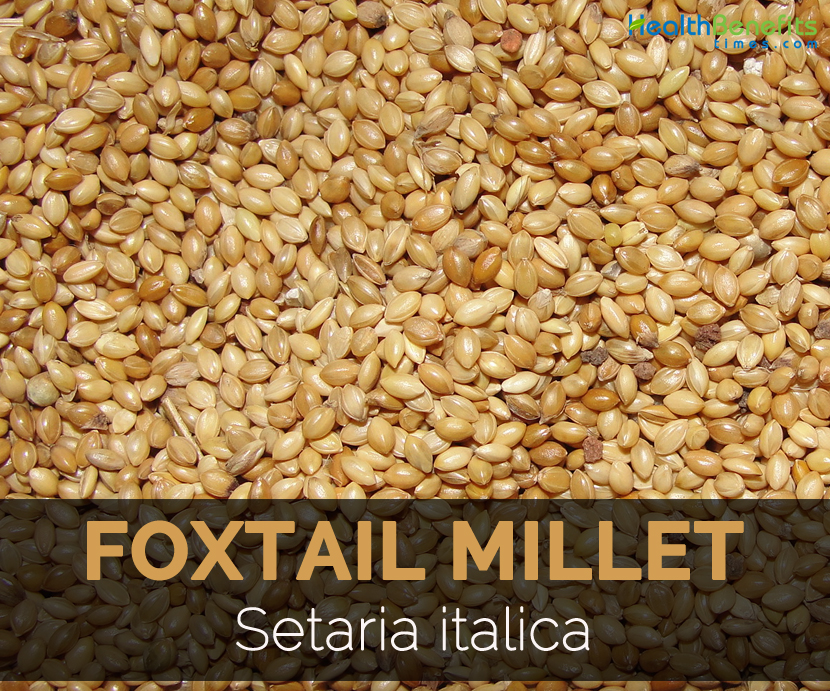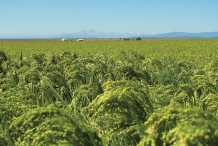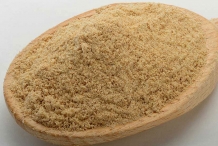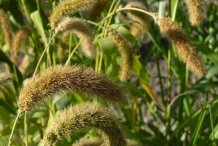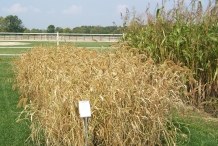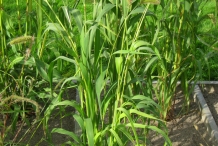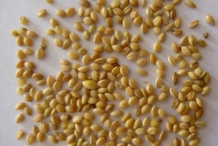History
Foxtail millet was first naturalized in China. The evidence shows the domestication of Foxtail millet in the Middle East and Europe which dates about 4000 years BP. The phylogenetic analyses show the green millet and foxtail millet is associated and the Foxtail millet is naturalized derivative of the green millet. Currently, Foxtail millet is sophisticated in Europe, America, Asia, Africa and Australia.
The evidence (early) shows that it was cultivated in China by Peiligang culture. Though the common millet was also cultivated, Foxtail millet becomes prevalent in the Yangshao culture. About 600 BC, it was cultivated in the Iron Age at Near East.
Plant
It is an annual grass with erect and robust culms. It grows upto the height of 60-150 cm. Leaves are 20-40 cm long and 1.5-3 centimeters wide with lanceolate shape. Leaf sheaths are small, glabrous or pubescent and 1-3 mm. Leaf lamina is dense, erect or pendent, lobed and 6-40 × 0.5-5 cm. It has elliptic, ovate or subglobose spikelets of 2-3 mm.
Nutritional value
100 grams of Foxtail millet contains 12 g of moisture, 351 calories, 11.2 g of protein, 4 g of total fat, 63.2 g of carbohydrate and 6.7 g of crude fiber. It grants 803 g of isoleucine, 1764 g of leucine, 103 g of tryptophan, 328 g of threonine, 233 g of lysine, 0.6 mg of thiamin, 63.2 g of carbohydrate, 2.8 mg of iron, 11.2 mg of protein, 3.2 mg of niacin, 4 g of lipid fat, 0.1 mg of riboflavin and 31 mg of calcium.
Health Benefits of Foxtail millet
Foxtail millets are rich in calories that provide energy and strength to the body to perform activities. It is widely cultivated in India, Africa and China. It is considered as the perfect substitute for the healthy diets.
- Proper function of cardiac
Vitamin B1 assists in the formation of neurotransmitter acetylcholine which helps to transfer the message between muscle and nerves. It also safeguards the functions of cardiac. The deficiency of Vitamin B1 leads to improper functions of cardiac. The patients of congestive heart failure finds Vitamin B1 helpful and prevents heart ailments.
- Alzheimer’s disease
Vitamin B1 slows the development of Alzheimer’s disease. It could be treated with an intake of 100 mg supplements of Vitamin B1. The trial studies are still carried out for the determination of the mechanism due to which it occurs.
- Enhance memory
Vitamin B1 helps to enhance the concentration and memory power. It helps to manage the nervous ailments such as Bell’s palsy and multiple sclerosis. It is also called morale vitamin which provides a positive impact on nervous system and supports mental perspective.
- Antioxidant
Vitamin B1 acts as an antioxidant which slows down the process of age spots, wrinkles and other age related problems that has negative effect on the organs.
- Cures muscle weakness
Iron is essential for the maintenance of the health of muscles. It is found in the muscle tissues and transports oxygen which is essential for the muscle contraction. The deficiency of iron leads the muscle to lose the elasticity and tone and may cause anemia. (1)
- Brain health
Iron assists in the brain development. It supplies oxygen to the brain, as it uses about 20% of blood oxygen. Iron is directly associated with the brain functions. The adequate amount of blood if received by the brain helps to promote the cognition and prevents Alzheimer’s disease and dementia. Due to this the adequate amount of iron is essential for the brain oxygenation. (2)
- Restless leg syndrome
The deficiency of iron in the body is the cause for the restless leg syndrome. The low presence of iron in the blood is the cause for this. The high intake of supplements of iron in adequate amounts helps to cure this condition. It is associated with muscle spasms which is the symptoms of deficiency of iron. (3)
- Nerve signals
Protein helps in the functions of nervous system smoothly. The activation of nervous system triggers the response of relevant reactions. The receptor sites consist of protein complex which helps to transfer the nerve signals to the cells and manage the central nervous system. (4)
- Hair health
Protein is essential for the maintenance of hair health and prevents it from damage. Protein has a vital role in the growth of hairs. Due to the beneficial effects, the hair care products use the protein in it. (5) (6)
- Skin health
Proteins support and strengthen the tissues such as skin which is tears constantly. Collagen is considered as the vital protein that strengthens the tissues, cells and organs that is essential for the revitalization. The high presence of collagen protein found in the body provides wrinkle free, healthy and youthful skin. (7) (8)
Traditional uses
- The grain of Foxtail millet is used in China as an astringent and emollient in choleric affections and diarrhea.
- The seeds are used in India as a diuretic, to strengthen virility, treat indigestion, dyspepsia and rheumatism.
- It helps to treat food stagnancy.
- The seeds (green) help to reinforce virility.
- The white seeds are useful for fever and cholera.
- In Pakistan, the crushed seeds are combined with ghee and consumed for the sexual vigor or potency.
- The decoction made from Setaria oil and bark of Acacia modesta is used as a tonic or to raise fertility in females and males.
- It is used in India to enhance vigor and treat bone fractures.
- The cooked grains are used in Chhattisgarh as a cure for diarrhea.
- The paste is externally used as a cure for swellings.
- It is combined with other herbs to cure dysuria.
- In Aurangabad, the decoction made from the whole plant is used internally for rheumatism and reduce the pains caused due to parturition.
- The seeds are used to treat diabetes.
- In Western Himalaya, it is combined with cow’s curd in order to treat measles.
Precautions
- The sensitive people might get allergic reactions so they should avoid it.
- It should be consumed in limited amounts.
How to Eat
- Seed are consumed as a sweet or savory food.
- Foxtail millet is used as a basic food in North Africa, South and East Asia and South Eastern Europe.
- The grain cooked in milk or water is consumed as rice.
- The seeds are grounded as flour and used to make porridge puddings, cakes and bread.
- The flour made by Foxtail millet is used to make noodles.
- Foxtail millet is combined with pulses in Northern China and cooked.
- In China, it is used to make millet crisp rolls, mini crisp chips and flour.
- In China, it is used to make wines and vinegar.
- In Myanmar and Russia, it is used to prepare alcohol and beer.
- In China, the seeds are sprouted and consumed as vegetable.
References:
http://www.hear.org/pier/species/setaria_italica.htm
https://npgsweb.ars-grin.gov/gringlobal/taxonomydetail.aspx?id=430572
http://www.pfaf.org/user/Plant.aspx?LatinName=Setaria+italica
http://www.plantnames.unimelb.edu.au/Sorting/Setaria.html
http://www.floracatalana.net/setaria-italica-l-p-beauv-
https://www.itis.gov/servlet/SingleRpt/SingleRpt?search_topic=TSN&search_value=41248#null
http://www.stuartxchange.org/Daua
https://www.organicfacts.net/health-benefits/vitamins/vitamin-b1-or-thiamine.html
Comments
comments
| Foxtail millet Quick Facts | |
|---|---|
| Name: | Foxtail millet |
| Scientific Name: | Setaria italica |
| Origin | Foxtail millet was first naturalized in China. |
| Colors | Light yellow-brown, rusty or black (Seed) |
| Shapes | Convex oval or elliptical (Seed) |
| Calories | 351 Kcal./cup |
| Major nutrients | Isoleucine (48026.32%) Leucine (47727.27%) Tryptophan (23409.09%) Threonine (18636.36%) Lysine (6967.70%) |
| Health benefits | Proper function of cardiac, Alzheimer's disease, Enhance memory, Antioxidant, Cures muscle weakness |
| More facts about Foxtail millet | |
